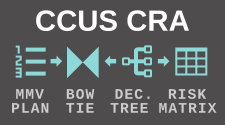
Organised by SPE Aberdeen and PESGB, the Carbon Capture, Utilisation and Storage (CCUS) virtual Conference was held from 21ˢᵗ to 24ᵗʰ February 2022, and featured current CCUS projects, case histories, technical initiatives, operating practices and panel discussions.
Richard Metcalfe attended the conference and gave a presentation on the importance of using multiple lines of evidence in the containment risk assessment (CRA) for underground storage of CO₂. Such an assessment involves making judgements about risks based on multiple lines of evidence, and presenting the outcomes to a range of stakeholders, including regulators.
A structured approach was presented, based on a combination of scenarios, decision trees, bowties and risk matrices. See Figure 1. Using real-world examples, the approach was illustrated by showing how it has been used previously to assess the risk of CO₂ leakage from wells, including those that are part of a CCUS project or legacy wells unrelated to the project.
There is a growing international consensus that CCUS will be necessary to expedite a cost-effective transition to a net zero carbon emitting economy and it will require an effective and transparent CRA for any proposed CO₂ storage site.
Quintessa is committed in continually building its existing expertise and knowledge in the sustainable utilisation of the subsurface by providing a leading-edge scientific input and consultancy to facilitate a low carbon future.
Figure 1: A structured approach to a Containment Risk Assessment for Carbon Capture, Utilisation and Storage
